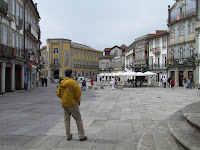To round out Mom and Dad's visit we surprised them with a car trip to Viana do Castelo on the Portuguese coast and to Santiago de Compostela in northern Spain, both remarkably close to Braga.
On Friday morning, we borrowed João's car again and headed west out of Braga for the Atlantic Ocean, then turned north to get to Viana do Castelo.
This is a very picturesque town. The centerpiece is the Praça da República. With cafes, linen shops, the old City Hall and the unique church, the Igreja da Misericórdia, with its elaborately carved balconies.
Any visit to Viana do Castelo is incomplete without a visit to the Natário cafe and bakery for their amazing Bolas de Berlim - Berlin Balls. These sweet Portuguese treats are a bit like doughnuts, but filled with an creamy eggy filling and then coated with cinnamon and sugar. They were so tasty we went back for seconds.
After this we headed up the coast towards Spain. The rocky shore is beautiful along here.
With a lot of help from the trusty TomTom GPS system we found our hotel in Santiago de Compostela - even when we were convinced it was wrong, it was right... Learn to trust the TomTom. This is another gem of a town. Lots of great streets to wander and plenty of great food.
We certainly enjoyed the Spanish tapas - it is a wonderful and delicious food tradition. The small bites and great flavors did lead some to express shock and mild outrage when someone went for the last one of a particular favorite. Luckily we all get along and such transgressions are quickly forgiven, even if a few eyes are rolled...
For lunch the next day we had heaps of paella and risotto - very tasty, and as the before and after pictures below may show, we were very full and satisfied afterward.
The most famous attraction in Santiago de Compostela is the cathedral, which houses the remains of St. James, yes, that St. James. It has been a pilgrimage destination for centuries. The dedicated faithful walk, often from their own front doors, to the cathedral, taking what is called Camino de Santiago. The most famous route leaves France and crosses northern Spain.
The front of the cathedral is fantastic - full of intricate designs and slightly crusty with all the lichen and small plants that make it their home.
Oddly, the door knockers are placed way out of reach, I don't know what this says about the accessibility of religion and the Catholic church in the middle ages. Maybe this is what Vatican II was all about, I'll have ask Peggy... ;)
The interior is quite dramatic and a bit over the top with no less than three statues of St. James on the altar. He is depicted in his roles as pilgrim, priest, and rather unfortunately, slayer of the Moors. When the Christians were chasing the Moors out of Spain and Portugal in the 10 and 11th century the image of St. James on his white horse was used to inspire the Christian troops. Needless to say, this bit of imagery is rightly downplayed these days.
In the picture above you may be able to see the amazing incense burner that hangs in the middle where the nave and transept intersect - click on the image to see the full size version. It weighs around 80 kilograms and is filled with 40 kilograms of charcoal and incense.
Peggy was lucky enough to see it in action and said it was amazing. She had stopped in for what she thought was the daily mass for pilgrims arriving that day but instead the mass being held was celebrating the fact that the church was consecrated on that day exactly 800 years ago. For such a special event they did use the big incense burner. Since it is so heavy there are 8 men holding the ropes (see below) pulling in time to steadily increase the swing until it takes about 6 seconds to complete one back-and-forth swing along length of the transept.
So, why such a large incense burner that would swing over so many of the worshipers in attendance? Well, consider a hot summer day in the middle ages and the cathedral filled with pilgrims who'd just walked across Spain and not enjoyed the same warm-shower-every-day ritual that we have these days. It had to be a, erm, powerful expression of their dedication to the pilgrimage!
Another interesting tidbit about the cathedral is that, during construction, the stone masons would mark the stones that they had worked on to ensure that they were properly paid. Markings like the one shown above appear all over the church.
The conclusion of our great weekend "up north" was another great Spanish breakfast. The bread from this region of Spain is well known for being very good. We had it toasted, rubbed with a tomato, drizzled in olive oil and topped with a slice of cheese - a simple but delicious combination of Spanish flavors. It goes great with the fresh squeezed orange juice as well!
After breakfast Sunday morning we drove back down to Braga, my parents repacked their bags, and we headed to Porto send them on the next leg of their Portuguese adventure. Viana do Castelo and Santiago de Compostela are fantastic towns, full of great sights and great food. If you're in the neighborhood, don't miss them.
~Eric

















No comments:
Post a Comment